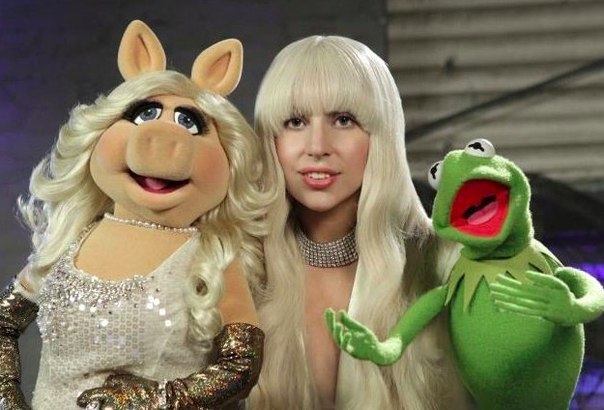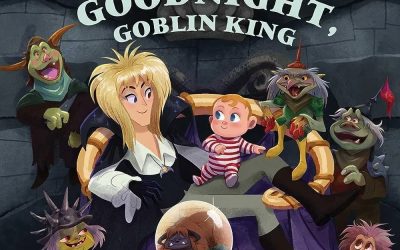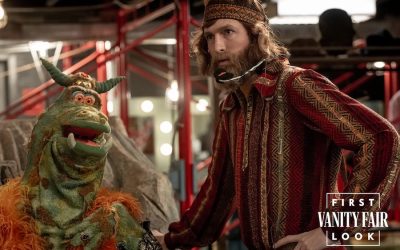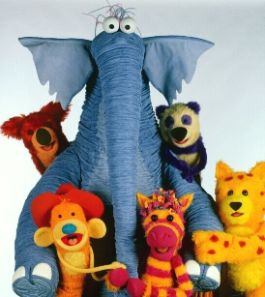
Here’s the ethical dilemma of the moment: There’s a new Henson show called Animal Jam that premiered this week. It’s pretty much Henson’s only new production right now, and it’s really, really not very good. In fact, and I am saying this with regret, it’s really quite bad.
But at this particular moment in the Henson Company’s history, for me to say that — and then to back it up with amusing examples, as I am duty-bound to do — it just feels like kicking a homeless dog and taking away its last chew toy. I mean, it was one thing to trash Tomie dePaola and Jack and the Beanstalk a year and a half ago, because Muppetfest was coming up, and everyone was generally feeling pretty optimistic about the Muppets. These days, it feels like they’re hanging on by their fingernails. The company still hasn’t sold, it’s not clear what’s going to be left when it does sell, and everybody seems depressed and anxious. So criticizing Henson’s one new show — no matter how ill-conceived and unwatchable it may in fact be — well, it doesn’t feel right.

On the other hand.
Given the state of the company, the entertainment industry and the economy as a whole, wouldn’t this be a nice time to start making good shows? I mean, I don’t know if that’s enough to save the company at this point. But it couldn’t hurt, could it?
So I’m just going to go ahead and review Animal Jam as I always do, with an eye toward providing some constructive criticism that will help future generations to make better TV shows.
First, a brief history of Animal Jam. I can admit up front that this history is entirely my own theory, based solely on the two press releases I’ve seen, the one episode I’ve watched, and my own frog-given common sense. But here goes.
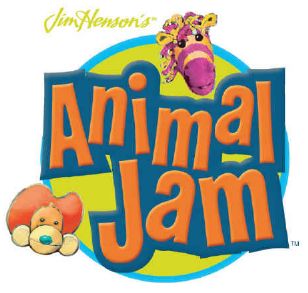
The history of Animal Jam goes like this: The Discovery Channel will not be satisfied just being one channel on your cable system. They want six channels, so they can really stretch out and make themselves at home. So they launch the Discovery Kids Channel, and pretty soon they figure out that it takes a heck of a lot of TV shows to fill a 24-hour cable channel 7 days a week. They start giving out money to production companies who can promise to make them some shows, really fast and really cheap.
So the Jim Henson Company — which, let’s face it, could use the money right now — promises to make them a show using six puppets, one set, and a lot of nature-show animal footage that the Discovery Channel already owns the rights to. And not only can they produce this show under budget, but also — and this is the beauty part — they can make the show “interactive.” Ch-ching! And so we have Animal Jam.
The show starts with half a song from Peter Lurye, the great songwriter who produced the music for Bear in the Big Blue House. I say that it’s half a song because it goes like this.
Heya heya heya oh-ah-ay
It’s an Animal Jam
Come on, dance! With Edie, and Waffle!
Dance any way you want to.
Heya heya heya oh-ah-ay
Now strike the zebra ready pose
And shake your cowboy monkey toes
Well, you’ve just got to.
Go Bozark!
Get to the jam, Animal Jam
Get to the Animal Jam
Get to the Animal Jaaaaaam
We’re having a jam, having a jam
Having an Animal Jam
Having an Animal Jaaaaaaam
We’re having an Animal Jaaaaaaaam
Three! Two! One!
Animal Jam!
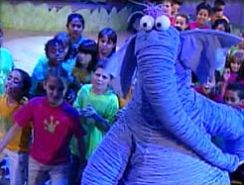
… Which is catchy enough, but if you take the character names and the show title out of it, there isn’t a lot of song left. I guess having half a theme song is one of the show’s many cost-cutting strategies.
The show itself takes place in a big empty studio full of six year old kids in brightly colored t-shirts. There’s lots of screens all over the walls that play images of puppets and animals and rotating stars. There’s lights that are constantly in motion, spraying red and yellow and blue spotlights across the walls and the floor. It’s kind of disorienting.
It’s even more unsettling when the puppets immediately start shouting at you, and never stop. “YEAH! ALL RIIIIIGHT!” says Edie the zebra. “WHOOO HOOOO!” says Waffle the monkey. “WELCOME to ANIMAL JAM!” says Edie. “We’re having us a DANCE PARTY, and you’re ALL INVITED!” says Waffle. “Do you feel like MOVIN’ and DANCIN’ with us?” says Edie. “Then LET’S JAM!” The kids in the audience jump and shout and clap, despite the fact that nothing applause-worthy has happened yet.
Welcome, in other words, to interactive TV.
“Interactive TV” is an extremely silly and worthless fad, but it’ll probably be with us for a long time, so we might as well get used to it. The whole concept, obviously, is oxymoronic — there’s nothing less interactive than broadcast television. In order for something to be “interactive,” I have to be able to interact with it, which means that my participation has to matter somehow. I can interact with a website — the Play with Me Sesame website is a decent example of this — because, on a basic level, my pointing and clicking has some effect on what happens on the screen. It talks to me, I “talk” back to it, and that’s an interaction.
But if something’s being broadcast at me on TV, then there’s no way that I can have any impact on what’s happening on screen. The show keeps going whether I feel like movin’ and dancin’ or not; I can’t even slow it down or pause it. In fact, it would keep going just the same, even if I choked on my breakfast cereal and passed out on the carpet. The “interaction” is only one-way, and therefore, we’re not interacting — it’s just acting upon me.
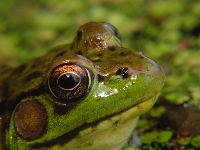
Which means, basically, that the show is shouting at me and giving me orders, and not very coherent ones. “Bullfrog belly breath!” they say, and then they show me a picture of a bullfrog breathing. Then they cut to a kid moving her arms out and then towards her stomach. “Breathe in deep! Now let it go!” That’s with a shot of a lion stretching on all fours. “Cow monkey neck roll! Roll, roll!” That’s with a shot of a monkey doing a somersault.
Then they show the kids rolling their heads around on their shoulders. This is all impossibly confusing. By the time I figure out what it is that they expect me to do, they’re doing something else. Plus, the motions that the kids in the studio are doing are not the same as what the animals in the nature-show footage are doing. It’s not immediately clear whether I’m supposed to be turning somersaults or just moving my head around, and the instruction “Cow monkey neck roll!” is only marginally helpful.
By the way, I’m not really trying to follow the instructions, of course. I’m just imagining what it would be like if I was trying. I don’t really feel like movin’ and dancin’, and nothing on the screen is making me want to do anything but sit on the couch and shake my head. I feel fairly comfortable that the children of the world are doing the same, if they haven’t already changed the channel or started drawing on the walls with magic markers.
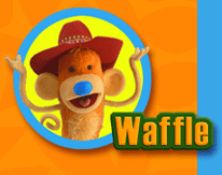
The opening song ends, and the kids all jump up and down and clap like something just happened. I actually feel tremendously sorry for these kids. This show was filmed at Walt Disney World/MGM Studios, which is one of the coolest places in the world to be. Instead of hanging around this big empty studio doing bullfrog belly breaths, these kids could be at MuppetVision 3D, or on the Pirates of the Caribbean ride.
What a hideous disappointment this must be for the kids, especially because the puppets don’t actually bother to talk to the kids, or even really acknowledge them in any way. The camera focuses on them sometimes, but the puppets are always talking to each other, or shouting instructions at the camera. There’s not a single moment in the whole episode when a puppet turns to a kid and even says hi, or asks what they’re doing. For a show that’s all about kid interaction, they don’t seem very interested in engaging with the kids in their own studio. The kids, essentially, are background filler.
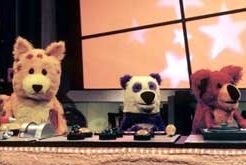
But who has time for the kids, when there’s a story like this: As the first dance ends, Edie turns to Waffle and asks if he’s excited about Bozark’s birthday party. Bozark is having an extra-special party after the show today, and here’s the kicker: Waffle has not been invited. When Edie says that Bozark sent invitations to all his friends, Waffle’s voice quavers: “Oh… to all his friends!” The three DJ’s — who are named, imaginatively, DJ One, DJ Two and DJ Three — have a big birthday cake for Bozark. Waffle starts to cry. “Is everything okay?” asks the observant Edie. “You look kind of sad. Doesn’t he look kind of sad?”
Waffle keeps crying and sniffling, but he claims that he’s just fine. “I don’t think so,” says Edie. “Sometimes, your body says things that your mouth can’t, or won’t, put into words.” (At this point, Waffle is sobbing hysterically.) “See the way you’re slumpin’, and shufflin’, and mopin’? That’s body talk, Waffle. Sad body talk. As opposed to this — ha ha ha, I’m happy, ha ha — that’s happy body talk. See the difference?”
Yeah, Edie, I pretty much have that down. Do you think you could possibly find out why your friend is having a nervous breakdown right in front of you? No? All right, suit yourself.
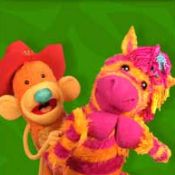
By the way, speaking of interaction: Can YOU guess the super-secret surprise ending of this story? Do you think maybe Waffle will get to go to the birthday party after all? (Hint: Yes.)
Then Edie sings a song about “Body Talk,” where we get to practice smiling when we’re happy and frowning when we’re sad. “Did you know that dogs show their feelings too? Let’s get down on the floor and act like mad dogs, and GROWL! There you go! Now, be sad! Now, be happy!” The kids are mostly swaying back and forth and occasionally moving their arms.
Today’s theme is actually perfect for the show as a whole, because it’s all about acting out how you feel — and then having absolutely no effect on anyone around you. There’s no sense that we should be scared of the angry dogs, or comfort the sad dogs. As long as you’re moving, basically, it doesn’t seem to matter that no one is paying attention to you.
“Now, move however you feel!” Edie shouts — and I have to imagine that, given the chance, most of these kids would be moving towards the door, to try to get to Space Mountain before the park closes.
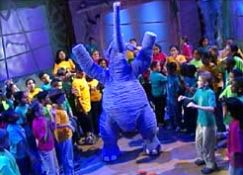
Next, Waffle sings a song called “Moody Moves,” which teaches us that your body shows how you feel. Observant readers will notice that this is exactly the same lesson as the last song, and it is. They show that they’re happy, they show that they’re sad, they show that they’re silly… they’re doing it all over again, to a different tune. This show is only twenty minutes long, and it’s a struggle for me to watch it all the way through without moving my trigger finger towards the fast-forward button. They need to stop asking me how I feel, because they will not be happy with my answer.
Edie and Waffle chatter some more about the birthday party, but then a blue light starts flashing, and we hear an elephant trumpeting. It’s Bozark, the Animal Jam superstar, who enters the studio through a cloud of dry ice.
I do have to take a moment here to say some kind words about Bozark the elephant, who’s a really amazing full-body puppet. He’s made of a light, ruffled material covering a metal frame, which allows him to move in really pleasing and unexpected ways. Bozark does a whole dance number, executing a lot of funny dance moves, wiggling his big body around, swinging his trunk, and punching the air with his big flat elephant hands. I like Bozark a lot. If the rest of the show was as surprising and clever as Bozark, then I wouldn’t be complaining about it like this.
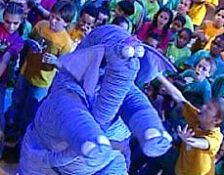
Unfortunately, his dance only lasts two minutes, and then we have to go back to the story. Waffle is still upset about the birthday party, but it turns out that — surprise! — he was invited after all, so everything’s okay.
Then the show ends, having utterly failed to enchant me in any way. Now, there’s a lot of sins that this show commits — it’s shouty, it’s repetitive, it’s sort of visually murky and confusing — but the worst sin, in my mind, is that the characters just don’t engage me. I could forgive a lot of sins for good characters, and these just aren’t good characters.
The problem — and I’m amazed that it took me twenty minutes to figure this out — is that they don’t have eyes. Bozark is the only character on the show that has the classic Muppet eyes, and it’s no coincidence that he’s the only one I care for. The other puppets all have little black teddy-bear eyes, which makes them look sort of cold and flat. Waffle’s eyes are especially bad — they’re tiny and really far apart, so it’s very hard to love him, no matter what he does. It’s like loving a reptile.
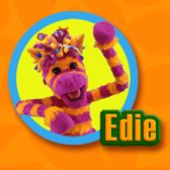
Now, I’ve been a Muppet fan forever, so I know all about Muppet eyes. Every time Muppet people talk about their characters, they’re always talking about how the eyes are the most important thing, that getting the eye focus on a puppet gives you the whole character. That’s the genius of Henson’s puppetry — giving them eyes that feel real and soulful, creating characters that you can relate to and identify with.
The Animal Jam puppets have eyes that are dark and tiny, eyes that communicate nothing and that are impossible to love. These characters, and this show, come from a very dark place in Henson Company history, a depressing time that I hope will soon be forgotten.
This would be a very good time for Henson to make a show that kids will love. This is not a good time for Animal Jam.
by Danny Horn

